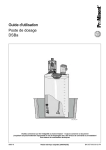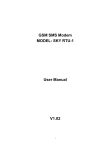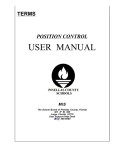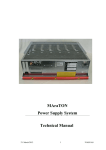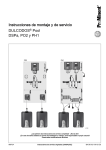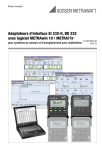Download Metering station DSBa Operating instructions
Transcript
Operating instructions Metering station DSBa P_DD_0008_SW Please carefully read these operating instructions before use! · Do not discard! The operator shall be liable for any damage caused by installation or operating errors! Technical changes reserved. 986965 Original operating instruction manual (2006/42/EC) BA DST 003 03/12 EN ProMinent Dosiertechnik GmbH Im Schuhmachergewann 5-11 69123 Heidelberg Germany Telephone: ++49 6221 842-0 Fax: ++49 6221 842-617 email: [email protected] Internet: www.prominent.com 986985, 2, en_GB © 2010 2 Supplemental instructions Supplementary information Read the following supplementary information in its entirety! Should you already know this information, you have an even greater need of the Operating Instructions. The following are highlighted separately in the document: Fig. 1: Please read! n Enumerated lists Instructions ð Outcome of the instructions - see (reference) Information This provides important information relating to the cor‐ rect operation of the device or is intended to make your work easier. Safety information Safety information is identified by pictograms - see "Safety Chapter". General non-discriminatory approach In order to make it easier to read, this document uses the male form in grammatical structures but with an implied neutral sense. It is aimed equally at both men and women. We kindly ask female readers for their understanding in this simplification of the text. 3 Table of contents Table of contents 4 1 Identify code overview.......................................................... 5 2 Safety Chapter...................................................................... 8 3 Storage and transport......................................................... 10 4 Overview of equipment....................................................... 11 5 Mounting and hydraulic installation..................................... 12 5.1 Notes.......................................................................... 12 5.2 Operating instructions................................................. 12 6 Installation, electrical........................................................... 14 7 Start up............................................................................... 15 8 Maintenance, repair and disposal....................................... 18 9 Technical data..................................................................... 19 9.1 Dimensions and Weights............................................ 19 9.2 Materials, wetted......................................................... 19 10 Declaration of Conformity................................................... 21 Identify code overview 1 Identify code overview Please enter the identity code given on the nameplate under "Type" into the bottom box below. DS Ba Metering stations with PE tank PE tank xxxxN xxxx l Metering tank PE, neutral colour (xxxx = 0035, 0060, 0100, 0140, 0250, 0500, 1000) xxxxS xxxx l Metering tank PE, black xxxxB xxxx l Metering tank PE, blue xxxxG xxxx l Metering tank PE, blue xxxxR xxxx l Metering tank PE, red Collecting pan 0 without collecting pan 1 with collecting pan, version with neutral colour 2 with collecting pan, coloured version (same colour as tank) Version 0 With ProMinent® Logo 1 Without ProMinent® Logo lock for tank screw top 0 no lock (for 35 l tank only) 1 with lock Hand mixer, stirrer 0 none A with PP hand mixer B, D, E, with PP manual stirrer F, G, C H with stainless steel electric stirrer 0.02 kW I, K, L with stainless steel electric stirrer 0.18 kW M with stainless steel electric stirrer 0.25 kW N with stainless steel electric stirrer 0.75 kW P with PVDF electric stirrer 0.02 kW R, S, T with PVDF electric stirrer 0.18 kW U with PVDF electric stirrer 0.25 kW W with PVDF electric stirrer 0.75 kW Metering pump mounting 0 without pump A for Beta®, gamma/ L B for Sigma/ 2/ 3 5 Identify code overview DS Ba Metering stations with PE tank C for Sigma/ 1 D for alpha E for Beta®, gamma/ L F, L, H for Sigma/ 1 J for Sigma/ 2/ 3 N for alpha P for delta Suction assembly selection 0 without suction assembly 1 Suction assembly with 6 x 4 mm suction hose 2 Suction assembly with 8 x 5 mm suction hose 3 Suction assembly with 12 x 9 mm suction hose 4 DN 10 suction assembly 5 DN 15 suction assembly 6 DN 20 suction assembly 7 DN 25 suction assembly 8 DN 32 suction assembly Suction assembly material 0 none 1 PVC 2 PP Suction assembly level switch 0 without level switch 1 2-stage, round plug, (6x4, 8x5, 12x9) for Beta®, gamma/ L 2 2-stage, round plug, (DN 10 - 32) for Sigma/ 1/ 2/ 3 Accessories - drain tap for storage tank 0 No accessories 1 with PVC ball valve, d16 hose nozzle 2 with PP ball valve, d20 hose nozzle Metering equipment 0 without metering equipment 1 with metering equipment d6 35/60 l 2 with metering equipment d8 60 l 3 with metering equipment d8 100/140 l 6 Identify code overview DS Ba Metering stations with PE tank 4 with metering equipment d12 250 l 5 with metering equipment d12 500/1000 l Info - Pump* e.g.: BT4b 1000 PPE 300UA000000 * Please enter the identity code of the selected pump. 7 Safety Chapter 2 Safety Chapter Identification of safety notes Warning signs denoting different types of danger The following signal words are used in these operating instructions to denote different severities of danger: Signal word Meaning WARNING Denotes a possibly dangerous situation. If this is disregarded, you are in a life-threatening sit‐ uation and this can result in serious injuries. CAUTION Denotes a possibly dangerous situation. If this is disregarded, it could result in slight or minor injuries or material damage. The following warning signs are used in these operating instruc‐ tions to denote different types of danger: Warning signs Type of danger Warning – automatic start-up. Warning – hand injuries. Warning – high-voltage. Warning – danger zone. Safety notes CAUTION! Observe the operating instructions of the metering pump. CAUTION! Chemicals can spray out of the tank opening When mixing, chemicals can spray out of the container opening. – – 8 Only use the stirrer when the tank is closed. Always keep the tank closed with a lid and lock. 35 litre storage tank: not lock available or required. Safety Chapter CAUTION! Caution, prevent material damage In the event that just one component of the metering station that comes into contact with the feed chemical is not compatible with it, material damage may occur. – Take into account the resistance of the material of all components coming into contact with the feed chemical when selecting it. Also make use of the ProMinent® resistance list in the product catalogue or at www.prominent.com. Only with electric stirrer: WARNING! Warning of severe injury to hands The rotating propeller of the electric stirrer and the stirrer shaft can cause severe injury to hands. – – Never reach into the metering tank when the elec‐ tric stirrer is running. Switch off the power supply to the stirrer and secure to prevent switching back on before opening the cover of the metering tank. CAUTION! The agitator shaft may be knocked When the level in the metering tank is too low, turbu‐ lences may result when agitating. That may cause knocking against the agitator shaft. – Before switching on the electric agitator, fill the metering tank with metering solution at least 20 cm above the propeller. CAUTION! Observe the "Stirrer operating instructions" Correct and proper use n ProMinent® DSBa metering stations may be used only to store liquid metering chemicals and for metering into hydraulic sys‐ tems. n Any other uses or modifications are prohibited. n ProMinent® DSBa metering stations are not designed to store and meter gaseous or solid media. n ProMinent® DSBa metering stations are not intended for unpro‐ tected outside use. n ProMinent® DSBa metering stations are not intended for use in EX zones. n ProMinent® DSBa metering stations are not intended for use with flammable media. 9 Storage and transport 3 Storage and transport Safety instructions CAUTION! Danger of material damage A fully mounted metering station may be damaged when transporting. – Only transport the metering station once the fol‐ lowing components have been dismantled: – Metering pump – Electric agitator (option) – Discharge tap (option) – Metering equipment (option) CAUTION! The agitator shaft may be knocked The agitator shaft can be knocked if transportation is carried out incorrectly. – Storage and transport temperatures Only transport the agitator shaft in a professional manner. Data Storage and transport temperature of the metering station 10 Value Unit 0 ... 50 °C Overview of equipment 4 Overview of equipment Modules which can be combined to produce a metering station: 9* 9* 9* 4* 4* 3 3 3 1 2 4* 1 1 8* 5 5 6 7* 6 P_DD_0020_SW Fig. 2: Metering station with bund, discharge tap or metering equipment 1 2 3 4 5 PE metering tank Bund, stackable Lock for tank screw top Electric agitator* / hand mixer / hand agitator Suction assembly 6 7 8 9 Float switch for suction assembly Discharge tap for tank * Metering equipment * Metering pump*, in accordance with order * ProMinent prepares these components for installation at a later date. To prevent damage occurring in transit they are packed sep‐ arately and included with the delivery. The customer carries out all on-site installation tasks. 11 Mounting and hydraulic installation 5 Mounting and hydraulic installation 5.1 Notes CAUTION! Secure the metering stations so that under no circum‐ stances can they tip over or "move off" due to an outof-balance stirrer. – – Screws and nuts used for attaching the metering pump, electric stirrer or metering equipment are already screwed into the positions in which they should be used when these units are attached. The diagrams in the chapter "Overview of equip‐ ment" should assist you in carrying out these tasks. A suction assembly or a hand mixer will be sup‐ plied pre-assembled (if included in the scope of supply). 5.2 Operating instructions The customer will need to mount or install the following units depending on the scope of supply: Drain tap 1. Remove the blue sealing stopper, below, from the plastic connector 2. Remove the adhesive strip above the O-ring on the drain tap. 3. Screw the drain tap tightly to the plastic connector. Metering equipment CAUTION! Feed chemical may leak out Feed chemical can leak from the suction hose of the metering equipment. – 12 Connect the suction hose before filling the metering tank. 1. Screw the tube retaining bracket (a plate) for the metering equipment to the top of the metering tank using the nylon screws. 2. Remove the adhesive strip above the O-ring on the metering equipment. 3. Push the metering cylinder for the metering equipment partly through the tube retaining bracket and screw the metering equipment tightly to the plastic connector below. 4. Cut the suction hose to length. 5. Connect the suction hose to the liquid end with the connector kit. Mounting and hydraulic installation Metering pump 1. Cut the suction hose to length. 2. Feed the level sensor cable (if included in the scope of supply) underneath the metering pump. 3. Unscrew the attachment screws for the metering pump from their holes in the metering tank. 4. Attach the metering pump using these screws (washers, ...). 5. Connect the suction hose to the liquid end with the connector kit. 6. Insert the level sensor cable into the "level switch" terminal of the metering pump. Electric stirrer CAUTION! The stirrer shaft may be knocked The stirrer shaft can be knocked if handling is carried out incorrectly. – Only handle the stirrer shaft in a professional manner. For metering tanks from 100 l: 1. Unscrew the 4 nuts, clamp rings and washers from the threaded rods on the metering tank. 2. Position the electric stirrer on the metering tank - flange seal! Position of the terminal box! - and secure. For 60 l metering tanks: 1. Place the flange seal over the small hole for the stirrer shaft on the top of the tank. 2. Insert the stirrer shaft from the inside through this small hole and through the flange seal. 3. Partly unscrew the grub screw at the end of the stirrer motor shaft. 4. Push the shaft of the stirrer motor over the stirrer shaft so that the drill hole in the stirrer shaft is positioned below the grub screw. 5. Tighten the grub screw (2.5 mm hex. socket). 6. Attach the stirrer motor to the metering tank with the fittings provided in the accompanying bag - do not forget the washers and clamp rings! Position of the terminal box! 1. Prior to filling the metering tank check that: Leak test n The suction line is connected n The shut-off valve is completely closed n The screw cap on the bottom of the metering equipment is tightly closed 2. Then fill the metering tank, e.g. with water and check for leaks. 13 Installation, electrical 6 Installation, electrical WARNING! Warning against electric shocks Electric shocks may result from incorrect installations. – – – – Electrical installation of electrical units must be car‐ ried out by an electrical technician. Connect the PE conductors of the electrical com‐ ponents. An electric stirrer must be fitted with a motor pro‐ tection switch. Carry out electrical installation of the metering pump in accordance with the operating instruc‐ tions. WARNING! Unexpected start-up is possible As soon as the metering station is connected to the mains, it is possible that the metering pump and, where fitted, the stirrer will start to operate. – – 14 Install an emergency cut-off switch in the power supply line or Integrate the metering station in the safety concept of the overall system and inform personnel about electrical isolating options. Start up 7 Start up Safety notes CAUTION! Observe the operating instructions of the metering pump! CAUTION! Chemicals can spray out of the tank opening When mixing, chemicals can spray out of the container opening. – – Only use the stirrer when the tank is closed. Always keep the tank closed with a lid and lock. 35 litre storage tank: not lock available or required. The point at the top of the suction assembly where the suction line and the level sensor cable exit must not be blocked or sealed! Air must be allowed to enter the metering tank here to equalise the pressure! Only with electric stirrer: WARNING! Warning of severe injury to hands The rotating propeller of the electric stirrer and the stirrer shaft can cause severe injury to hands. – – Never reach into the metering tank when the elec‐ tric stirrer is running. Switch off the power supply to the stirrer and secure to prevent switching back on before opening the cover of the metering tank. WARNING! Danger of electric shock A mains voltage may exist inside the stirrer motor housing. – If the stirrer motor housing has been damaged, you must disconnect it from the mains immediately. It may only be returned to service after an author‐ ised repair. 15 Start up CAUTION! The agitator shaft may be knocked When the level in the metering tank is too low, turbu‐ lences may result when agitating. That may cause knocking against the agitator shaft. – Observe the limitations due to the feed chemical being used Before switching on the electric agitator, fill the metering tank with metering solution at least 20 cm above the propeller. Temperature Feed chemical temperature, max. 30 °C 1.4 g/cm³ Density Feed chemical density, max. Viscosity The allowable viscosity of the feed chemical forms an upper limit above which the following units cannot be used: Unit Maximum viscosity Metering pump 200 mPas Metering pump with valve springs 500 mPas Electric stirrer 500 mPas Determine the capacity using the metering equipment (option) 1 2 3 4 1 2 Normal position "Metering" or "Fill the metering cylinder" When calibrating "Block the tank feed" (measurement) same as 1 "Block the suction line feed" 4 3 P_DO_0021_SW Fig. 3: Position of the ball valve The metering equipment enables you to determine the capacity of the metering pump: Materials required: 16 Start up n Stop watch n Pocket calculator 1. For filling the metering cylinder, turn the ball valve to position 1. ð It will fill to the current liquid level of the metering tank the higher the better. 2. Turn the ball valve to position 2. ð The metering cylinder is now separated from the tank and only connected only to the suction line. 3. Note the liquid level of the metering cylinder and the back pressure of the metering pump. 4. Start the metering pump and a stopwatch at the same time. 5. Stop the metering pump and the stopwatch at the same time, after a set time or shortly before the metering cylinder is empty. 6. Read off the liquid level in the metering cylinder. Each scale marking is 0.5 cm3 or 1 cm3 depending on the version. 7. Subtract the liquid levels from one another and divide by the time recorded. 8. Enter this capacity together with the back pressure into the log book. 9. Turn the ball valve back to position 1. Position 4 on the ball valve closes the feed to the suc‐ tion line. In this position, e.g. it is possible to exchange the suction line when the metering tank is full. 17 Maintenance, repair and disposal 8 Maintenance, repair and disposal Maintenance and repair WARNING! Before working on the storage tank, disconnect the stirrer from the power supply and secure to prevent switching back on. CAUTION! Observe the operating instructions of the metering pump and, when necessary, the electric stirrer. CAUTION! Deposits adhering to the propeller can cause an imbal‐ ance. Regularly remove any adhering deposits from the pro‐ peller. Disposal CAUTION! Note the respective regulations currently applicable in your country! CAUTION! Observe the operating instructions of the metering pump. 18 Technical data 9 Technical data You will find the technical data for the metering pump and, when necessary, the electric agitator in the product specific operating instructions. 9.1 Dimensions and Weights Metering tanks Bund Capacity Diameter Height Net weight l mm mm kg 35 350 - 485 3.5 60 410 - 590 5 100 500 - 760 7 140 500 - 860 9.5 250 650 - 1100 17.5 500 820 - 1190 24.5 1000 1070 - 1260 51 Capacity Diameter d Diameter D Height Net weight l mm mm mm kg 35 565 507 220 2.9 60 680 607 270 4.5 100 802 727 320 6.5 140 811 727 370 7.3 250 917 807 520 11.3 500 1155 1009 670 16.5 1000 1280 1200 900 34.0 9.2 Materials, wetted Metering station Module Material Metering tanks PE Bund PE Suction assembly (according to PP / EPDM or Identcode) PVC / PP / FPM Suction assembly Suction hose PE Discharge tap (according to Identcode) PP / EPDM or PVC / FPM Metering equipment PVC / NP / EPDM / FPM 19 Technical data Electric agitator (according to Ident‐ code) Module Material Metering equipment Suction hose PVC, flexible Metering pump see the product-specific oper‐ ating instructions Hand mixer PP Electric agitator (according to Identcode) Ä ‘ Electric agitator (according to Identcode)’ on page 20 PVDF Components Tank size 60 l ... 500 l 1,000 l Stirrer shaft PVDF PVDF Propeller PP PVDF Flat seal FPM - Stainless steel 1.4571 Components 20 Tank size 60 l ... 500 l 1,000 l Stirrer shaft 1,4571 1,4571 Propeller PP PVDF Flat seal FPM - Declaration of Conformity 10 Declaration of Conformity - Original - EC Declaration of Conformity for Machinery We, ProMinent Dosiertechnik GmbH Im Schuhmachergewann 5 - 11 D - 69123 Heidelberg, Germany hereby declare that the product identified below conforms to the basic health and safety requirements of the EC Directive, by virtue of its design and construction, and in the configuration placed on the market by us. This declaration is no longer applicable if changes are made to the product without our authorisation. Product description: Dosing station container Product type: DSBa… Serial no.: see type plate on the unit Applicable EC Directives: EC Machinery Directive (2006/42/EC) EC EMC Directive (2004/108/EC) The safety objectives of the Low Voltage Directive 2006/95/EC were complied with in accordance with Appendix 1, No. 1.5.1 of the Machinery Directive 2006/42/EC Applied harmonised standards, especially: EN ISO 12100, EN 809 Technical documentation was compiled by the authorised representative for documentation: Dr. Johannes Hartfiel Im Schuhmachergewann 5-11 D - 69123 Heidelberg Date / Manufacturer signature: 01.03.2012 Name / position of the signatory: Joachim Schall, Manager Innovation and Technology 21





















